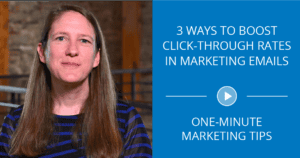How B2B marketing is changing
If you’re a B2B company trying to navigate your business through the pandemic, you may feel like you’re sailing a familiar boat on an unfamiliar body of water. If you’re like most B2B businesses, your customers have made a dramatic shift to digital since COVID-19 hit. As many as 47% of North American buyers now primarily purchase through self-serve digital channels, up 28%. As a result, your B2B marketing strategy needs to follow.
This shift to digital may have you thinking your customers aren’t looking for a personal touch. In reality, that’s far from true. You might start thinking of your business as H2H (human-to-human)—customers are much more likely to take notice when you respond with compassion and empathy, delivering relevant products and services they need now.
As the evolution of B2B marketing ebbs and flows, we have a few tips on how you can thrive during the pandemic and beyond.
Change #1: Digital experiences expand rapidly
Live chats. Self-serve digital purchases. Mobile app orders. It’s all become a bigger part of the B2B sales landscape. In fact, B2B customers are two times more likely to prefer digital interactions over traditional ones. So, B2B companies who were prepared with an outstanding digital presence are coming out winners.
Unfortunately, buyers say only one-third of businesses were ready for the digital influx. With complaints of slow response times, inconsistent pricing and lack of transparency into inventory, 35% of B2B buyers said better digital experiences drove them to new vendors.
As a B2B marketer, you may be asking, “How can we become a digital vendor of choice?”
- Start by auditing your buyer’s digital journey.
- If you don’t have an ecommerce site, consider how you might sell online. Optimize the buyer’s journey on your website to make buying easy and convenient. Eliminate barriers, like numerous clicks to place an order, difficulty finding products or technical bugs.
- Be up front about supply availability. Like any relationship, honesty and transparency is key.
- Consider personalized, real-time pricing—two-thirds of North American B2B buyers say they would switch to companies that make this part of their B2B marketing strategy.
- Hold virtual events to provide updates on your company or information on your products and services.
- Revolve your B2B content marketing around what your customer wants and needs to hear. Get to know their biggest anxieties and desires, shift your content to be more about useful advice, practical tips and how your business can help them.
Change #2: Inside sales and outside sales blend
The divide between external and inside sales was diminishing even before COVID-19. Now that most outside sales have screeched to a halt, forecasts show inside sales will overtake external sales, with 80% or more of the sales cycle happening in remote settings. Those who have made the switch it isn’t all that bad. Sixty-five percent of B2B decision makers say remote selling is at least as or even more effective than pre-pandemic sales methods.
So, as the evolution of B2B marketing continues, B2B sales and marketing leaders can use these inside sales tips to help keep sales churning:
- Deliver speed, transparency and expertise—the top three things buyers value most.
- Give a human touch in both inside and outside sales.
- Develop a group of digital sales experts who can help external salespeople migrate sellers online and help them use online tools.
Change #3: Speed and agility win
Because of B2B’s changing landscape, buyers are valuing speed more than anything. Take a look at how quickly you are able to respond to customer inquiries. When it comes to delivering thoughtful responses, the hare wins the race. And, an outstanding customer experience is sure to keep your relationships strong well beyond COVID-19.
Take a look at your processes to determine what can be streamlined. For one company, a dramatic change came about after reorganizing their customer service system with a combination of virtual and on-site processes. The company reduced service call times from almost 2 hours to 28 minutes. Even more impressive—they made the change in just 48 hours.
How can you do something similar? Talk to your customer-facing employees to hear what they have to say about interactions. Analyze any live chat transcripts to look at response times and customer satisfaction. Poll existing customers to see how they’re feeling. Staying informed of your customer service experience will clue you in on what you’re doing well and where you could improve.
Change #4: Account-based marketing adoption grows
If a company was simply experimenting with B2B account-based marketing (ABM) before, it’s now become an absolute requirement in order to grow. As one marketing expert says, “In a crowded marketplace, ABM is one of the most efficient and effective marketing practices B2B organizations can leverage.” Personalizing your marketing messages to prospects most likely to convert is always a smart B2B marketing strategy. Now, it just takes on a more digital flair than before.
For example, direct mail used to be a major part of ABM, but now that your prospects may be working from home, direct mail is likely less influential. However, personalized, thoughtful and well-crafted emails are still a great way to show relevance and empathy.
If your marketing department already has an ABM list, keep your horizons open for comparable companies outside your list who display intent signals and have similar purchasing power. Adding new accounts to your ABM list can help your company stay stable and even grow as the evolution of B2B marketing continues to unfold.
From doing more inside sales to emphasizing speed and zeroing in on your ABM strategy, the “how B2B marketing is changing” question is slowly being answered. Use these tips to set your sails on a B2B marketing strategy that’ll set the right course now and in the future. Need help? We’d love to talk!




